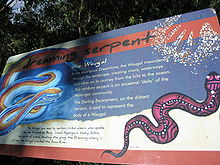Wagyl
The Wagyl (also Waugal or Waagal ) is a mythical being of the Noongar culture. It is a being from the dream time of the Australian Aborigines , a snake that formed the Swan River and Canning River, as well as other waterways and landforms near Perth and southwestern Western Australia .
myth
The rainbow serpent , a mythical being in almost all of the original Aboriginal dreamtime ideas, created the universe and humans and gave the Wagyl, a smaller but nonetheless powerful serpentine being, the ability to create rivers, lakes, rivers and animals. The Wagyl serpent, in turn, commissioned the Noongar to protect the land. The Noongar elders (tribal elders) who report on the Dreamtime are said to have the ability to see the Wagyl snake.
The rock walls of Darling Scarp , mountains to the east of the Swan Coastal Plain near Perth , are said to represent the physical imprint of the Wagyl snake, which meandered through the country and formed the contours of the hills and watercourses and gullies, as well as the lakes, for example the lake Monger . The snake is below the springs. As the Wagyl glided across the land, it created the sand dunes and its body formed the courses of the rivers, and where it stopped occasionally, river banks and lakes were formed. Rocks are their ejection and they are especially sacred. As she moved, her scales fell off and these became forests and tree landscapes.
It is possible that the Wagyl stories that have been passed down orally have a real background to the earlier Australian megafauna , on a strangler snake , the Wonambi naracoortensis , which reached a length of five to six meters.
today
The snake rested at the foot of Mount Eliza and this place is sacred to the Noongar. The former Swan brewery is located here. When the Noongar groups wanted this land back, a Noongar protest camp was set up there between the late 1990s and early 2000s.
Today older Noongar Aborigines walk along the Swan River and tell the young Aborigines about the dream time of the Wagyl snake.
literature
- Wilkes, Richard. Societal value systems for water resources in Western Australia Water symposium
- Flannery, Tim (2002) The Future Eaters: an Ecological History of the Australian Lands and People ISBN 0-8021-3943-4
Web links
- Maps and Mythologies: A Story of Cultural Clash, Perth, Western Australia at www.west.com.au , accessed July 10, 2010
- The Wagyl (The Nyoongar Rainbow Serpent) on www.savenorthlake.com.au (PDF file; 205 kB)
Individual evidence
- ^ Rosemary Van den Berg Changing Years , Journal of the South Pacific Association for Commonwealth Literature and Language Studies , 1993
- ↑ Age of the Megafauna ABC Science website 'Oz Fossils' (2008)

